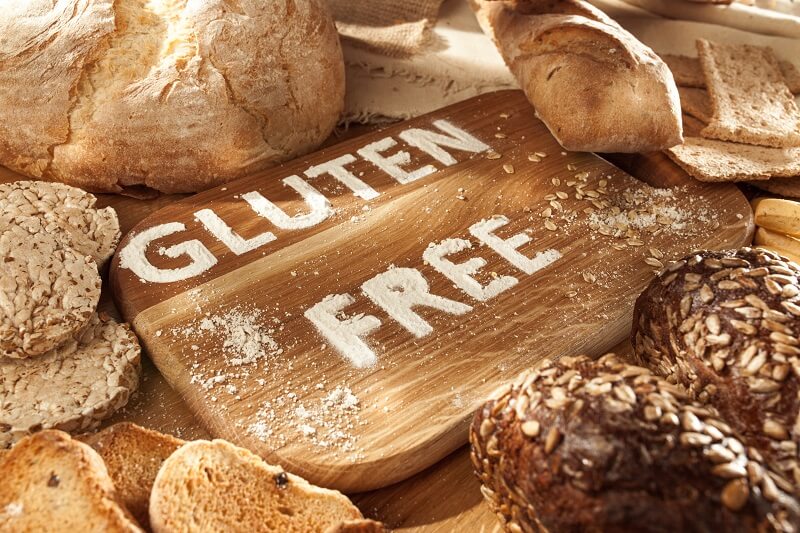Gluten-free diet – is it worth it or not?
- What is gluten actually?
- Celiac disease, gluten allergy and gluten intolerance – fundamental differences
- Celiac disease is a celiac disease characterized by a permanent intolerance to gluten.
- A gluten allergy is significantly different from classic celiac disease.
- Gluten intolerance is diagnosed in patients after excluding celiac disease and gluten allergy
- Should I follow a gluten-free diet without any significant health reasons?
- Gluten-free diet – sociological and social aspects
- Summary
In recent years, we've heard more and more about the negative effects of gluten on the human body. The number of patients who, for various reasons, are unable to consume this food component is also increasing significantly. Gluten-free products are becoming increasingly popular on the market, significantly improving the quality of life for patients with celiac disease or gluten allergy. Furthermore, it's puzzling that more and more people are switching to such a diet without good reason. This raises the question of whether such behavior is sensible or the result of a kind of fad. We will attempt to answer these and other questions about gluten in this article. We invite you to read it.
What is gluten actually?
It's impossible to talk about gluten without knowing it inside and out. Gluten is a specific group of plant proteins, actually a mixture of glutenin and gliadin. They are commonly found in many grains, but we can also find them in other foods, including flour. Interestingly, it has a positive effect on the flavor and organoleptic properties of many products. That's why manufacturers often add it to hot dogs, sausages, meat, as well as soups and sauces. All this means that we can find it in virtually all products. This ingredient is also responsible for the proper consistency of cakes, but also gives them resistance to drying out, flexibility, and increases kneadability. It's also worth mentioning its name, as it somewhat explains its properties. Gule is English and means glue. In addition, when it comes into contact with water, it begins to swell, forming a sticky mass. This makes it significantly more difficult for water to escape from the resulting product. This also explains why it is so valued in the sausage industry.
Celiac disease, gluten allergy and gluten intolerance – fundamental differences
In fact, there are people for whom consuming gluten can have serious health consequences. Gluten-free products have been developed for these patients. Although these disease entities, often referred to as gluten intolerance, actually differ from one another in many factors, their course, and their mechanism of development.
Celiac disease is a celiac disease characterized by a permanent intolerance to gluten.
It is a genetically determined autoimmune disease. This means that the body's own immune cells begin to attack our own tissue. Consuming gluten, even in small amounts, can lead to atrophy of the intestinal villi. These are small structures in our intestines that increase the surface area for the body's absorption of nutrients. Their destruction significantly impairs absorption and thus leads to a deficiency of many substances. This usually leads to malnutrition, but can also lead to the development of rickets or anemia. It is worth noting that celiac disease is most commonly diagnosed in children. However, this does not mean that it cannot occur at any age. Diagnosis of this disease requires comprehensive diagnostics and professional medical evaluation. Currently, a biopsy of the small intestine is helpful, as are specialized blood tests. The basic symptoms include diarrhea and flatulence, especially after consuming gluten-rich foods. In children, however, weight loss, growth retardation, arthritis, skin rash, or rickets are quite common. It's worth noting that this disease is impossible to diagnose without specialist help. Currently, virtually the only treatment is for patients to adhere strictly to a gluten-free diet.
A gluten allergy is significantly different from classic celiac disease.
Simply put, it's a type of food allergy—most commonly to wheat, but sometimes to other gluten-containing products. Interestingly, this disease occurs almost exclusively in children, although diagnoses can occur at a later age. It's worth noting that some patients outgrow it after puberty. The basic symptoms include diarrhea, vomiting, flatulence, a runny nose, difficulty breathing, and various skin changes. These symptoms usually appear within minutes of consuming gluten-rich foods, but can also appear several hours later. Although this type of hypersensitivity to these substances is not as dangerous to health as celiac disease, it should not be underestimated and attempts should be made to limit gluten consumption, at least temporarily. There have been reported cases of severe anaphylactic shock, which is extremely dangerous to health and life.
Gluten intolerance is diagnosed in patients after excluding celiac disease and gluten allergy
Such people simply don't tolerate this substance well for some reason and suffer from headaches, diarrhea, or skin rashes after consuming gluten-containing products. Treatment for this condition primarily involves limiting gluten consumption, and the patient may remain under close medical supervision. This is used to assess symptoms and determine when the diet can be discontinued. Interestingly, the mechanism of this food intolerance is not yet fully understood. Many experts even claim that it can be caused by other food ingredients—not necessarily gluten.
Should I follow a gluten-free diet without any significant health reasons?
Gluten has recently become one of the most controversial food ingredients. On the one hand, people suffering from the three diseases mentioned above should definitely limit its consumption or eliminate it altogether. Furthermore, there are some who argue that, over the course of evolution, our bodies have not fully adapted to the presence of gluten in our daily diet. However, it should be noted that excluding it from the diet of healthy people does not bring any health benefits and can even be harmful. This is because products naturally rich in this ingredient are simply necessary for our proper functioning. For example, fiber, which is found in large quantities in cereals and, consequently, in their milled products, is very important for proper intestinal function. Excluding it can lead to constipation. A deficiency of this nutrient can also lead to significant deficiencies in vitamins and minerals, as products such as pasta, bread, and all cereals are an important source of it. It is true that even gluten-free products contain gluten. However, it should be remembered that its content is usually much smaller. Therefore, in the case of a gluten-free diet, supplementation is recommended. We would like to add that virtually all reliable scientific studies on the alleged harmfulness of gluten indicate that without such evidence, it is not worth abstaining from gluten consumption. After all, gluten also performs important functions in our body. For example, it impairs the proper functioning of the intestines, and its deficiency can disrupt the proper balance of intestinal flora. Interestingly, its deficiency has also been shown to weaken the heart in healthy people.
Gluten-free diet – sociological and social aspects
A gluten-free diet is not just one of many dietary styles, but also has a social and sociological aspect. This is influenced by many factors. For example, the presence of gluten in so many products can lead to a kind of consumer rebellion and the desire to choose products with low or no gluten content. Furthermore, this type of diet is simply fashionable, and we often reach for these gluten-free products without being aware of the potential health effects. Let's add that manufacturers very often put information stating that the product does not contain gluten, even on foods that actually don't. A good example is legumes, or even fruits, vegetables, and potatoes. This increases their popularity and the likelihood that customers will reach for them. Yes, it is very beneficial and helpful for people who truly cannot consume it and who seek out such products every day. After all, gluten-free foods were developed for them, and this should be their purpose. Eating gluten-free products is not a bad thing either. They can be an excellent addition to your diet, but many products don't naturally contain them. Keep in mind, however, that completely avoiding gluten-containing products without specific health advice can simply be harmful to your health.
Summary
Despite its undisputed popularity, a gluten-free diet isn't particularly good for healthy people. While it's practically the only treatment for celiac disease, gluten allergy, or gluten intolerance, this doesn't mean that gluten itself is harmful to our bodies. Quite the opposite: it affects many processes in our body. Like many other substances, it has found its function in the body, and there's absolutely no need to limit its consumption to extremes. Moreover, it's present in so many products that completely avoiding them would also mean limiting the body's supply of many other health-promoting chemical compounds.
THE PUBLISHER'S CHOICE
Dried plums 1 kg BIOGO
- £6.07
- £6.07
- Prezzo unitario
- / per
Dried White Mulberries 500 g ORGANIC
- £5.06
- £5.06
- Prezzo unitario
- / per
Almonds 1 kg BIOGO
- £10.13
- £10.13
- Prezzo unitario
- / per
Cranberries sweetened with apple juice organic 1 kg BIOGO
- £14.19
- £14.19
- Prezzo unitario
- / per
Dried dates 1 kg BIOGO
- £3.65
- £3.65
- Prezzo unitario
- / per
Unpeeled buckwheat groats 1 kg BIOGO
- £2.44
- £2.44
- Prezzo unitario
- / per
Walnuts 800 g BIOGO
- £7.50
- £7.50
- Prezzo unitario
- / per
Peeled sunflower seeds 1 kg BIOGO
- £2.63
- £2.63
- Prezzo unitario
- / per
PULLED ORGANIC SUNFLOWER SEEDS 1 KG BIOGO
- £3.85
- £3.85
- Prezzo unitario
- / per












































































































































